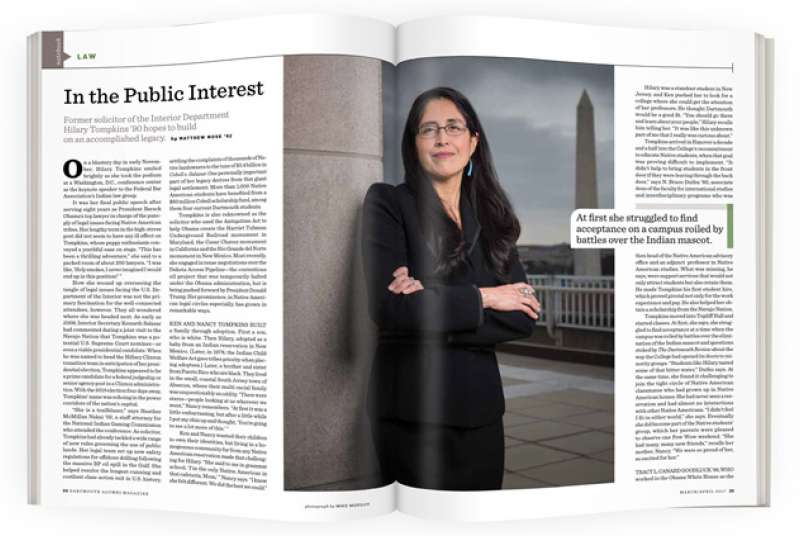
In the Public Interest
On a blustery day in early November, Hilary Tompkins smiled brightly as she took the podium at a Washington, D.C., conference center as the keynote speaker to the Federal Bar Association’s Indian law group.
It was her final public speech after serving eight years as President Barack Obama’s top lawyer in charge of the panoply of legal issues facing Native American tribes. Her lengthy term in the high-stress post did not seem to have any ill effect on Tompkins, whose peppy enthusiasm conveyed a youthful ease on stage. “This has been a thrilling adventure,” she said to a packed room of about 200 lawyers. “I was like, ‘Holy smokes, I never imagined I would end up in this position!’ ”
How she wound up overseeing the tangle of legal issues facing the U.S. Department of the Interior was not the primary fascination for the well-connected attendees, however. They all wondered where she was headed next. As early as 2009, Interior Secretary Kenneth Salazar had commented during a joint visit to the Navajo Nation that Tompkins was a potential U.S. Supreme Court nominee—or even a viable presidential candidate. When he was named to head the Hillary Clinton transition team in anticipation of her presidential election, Tompkins appeared to be a prime candidate for a federal judgeship or senior agency post in a Clinton administration. With the 2016 election four days away, Tompkins’ name was echoing in the power corridors of the nation’s capital.
“She is a trailblazer,” says Heather McMillan Nakai ’02, a staff attorney for the National Indian Gaming Commission who attended the conference. As solicitor, Tompkins had already tackled a wide range of new rules governing the use of public lands. Her legal team set up new safety regulations for offshore drilling following the massive BP oil spill in the Gulf. She helped resolve the longest-running and costliest class-action suit in U.S. history, settling the complaints of thousands of Native landowners to the tune of $3.4 billion in Cobell v. Salazar. One personally important part of her legacy derives from that giant legal settlement: More than 1,000 Native American students have benefited from a $60 million Cobell scholarship fund, among them four current Dartmouth students.
Tompkins is also reknowned as the solicitor who used the Antiquities Act to help Obama create the Harriet Tubman Underground Railroad monument in Maryland, the Cesar Chavez monument in California and the Rio Grande del Norte monument in New Mexico. Most recently, she engaged in tense negotiations over the Dakota Access Pipeline—the contentious oil project that was temporarily halted under the Obama administration, but is being pushed forward by President Donald Trump. Her prominence, in Native American legal circles especially, has grown in remarkable ways.
Ken and Nancy Tompkins built a family through adoption. First a son, who is white. Then Hilary, adopted as a baby from an Indian reservation in New Mexico. (Later, in 1978, the Indian Child Welfare Act gave tribes priority when placing adoptees.) Later, a brother and sister from Puerto Rico who are black. They lived in the small, coastal South Jersey town of Absecon, where their multi-racial family was unquestionably an oddity. “There were stares—people looking at us wherever we went,” Nancy remembers. “At first it was a little embarrassing, but after a little while I put my chin up and thought, ‘You’re going to see a lot more of this.’ ”
Ken and Nancy wanted their children to own their identities, but living in a homogenous community far from any Native American reservation made that challenging for Hilary. “She said to me in grammar school, ‘I’m the only Native American in that cafeteria, Mom,’ ” Nancy says. “I know she felt different. We did the best we could.”
“I believe we are providing a good foundation for the next administration to engage with tribes in a mutually respectful fashion.”
Hilary was a standout student in New Jersey, and Ken pushed her to look for a college where she could get the attention of her professors. He thought Dartmouth would be a good fit. “You should go there and learn about your people,” Hilary recalls him telling her. “It was like this unknown part of me that I really was curious about.”
Tompkins arrived in Hanover a decade and a half into the College’s recommitment to educate Native students, when that goal was proving difficult to implement. “It didn’t help to bring students in the front door if they were leaving through the back door,” says N. Bruce Duthu ’80, associate dean of the faculty for international studies and interdisciplinary programs who was then head of the Native American advisory office and an adjunct professor in Native American studies. What was missing, he says, were support services that would not only attract students but also retain them. He made Tompkins his first student hire, which proved pivotal not only for the work experience and pay. He also helped her obtain a scholarship from the Navajo Nation.
Tompkins moved into Topliff Hall and started classes. At first, she says, she struggled to find acceptance at a time when the campus was roiled by battles over the elimination of the Indian mascot and questions stoked by The Dartmouth Review about the way the College had opened its doors to minority groups. “Students like Hilary tasted some of that bitter water,” Duthu says. At the same time, she found it challenging to join the tight circle of Native American classmates who had grown up in Native American homes. She had never seen a reservation and had almost no interactions with other Native Americans. “I didn’t feel I fit in either world,” she says. Eventually she did become part of the Native students’ group, which her parents were pleased to observe one Pow Wow weekend. “She had many, many new friends,” recalls her mother, Nancy. “We were so proud of her, so excited for her.”
Tracy L. Canard Goodluck ’96, who worked in the Obama White House as the senior associate director of public engagement, remembers watching on C-SPAN in 2009 as Tompkins sat for her U.S. Senate confirmation hearings to take the role of solicitor for the Department of the Interior. When Canard Goodluck was a student, she had heard about Tompkins, because “we all knew who went before us. We are really connected to Dartmouth and to each other.” Canard Goodluck says she had a strong feeling Tompkins would be uniquely suited to navigate the treacherous legal issues that often arise between Native American tribes and the federal government. “You have to have a lot of patience, know your priorities,” Canard Goodluck says.
Tompkins’ preparation to handle those issues began shortly after Dartmouth, when she traveled across the country to interview for an internship with the Navajo Nation Department of Justice in the town of Window Rock, Arizona, near the New Mexico border. A government major, she had initially thought about a career in the foreign service, but after her exposure to her Native roots at Dartmouth knew she wanted to first soak in the life and culture of a reservation. “I felt like I was called there,” Tompkins says of returning to her birthplace.
When she arrived on the reservation, though, she discovered that despite her genetic ties to the tribe, she was now an outsider. “People would say, ‘You don’t sound Navajo. You don’t look Navajo. You don’t walk Navajo. You don’t talk Navajo,’ ” she says. “I sounded like New Jersey.”
Tompkins spent three years in Window Rock, immersing herself in the culture and learning the language and legal system. In the Navajo justice department she handled a range of cases under laws that were a hybrid between the U.S. code and one guided by tribal principles. She had a gift for the work, which included counseling disadvantaged families and negotiating tribal borders. Her colleagues encouraged her to take the Navajo bar exam, which does not require a law degree. As she built her legal career Tompkins attracted the interest of her tribal relatives—including her birth mother—who discovered Tompkins had returned.
Tompkins describes reconnecting with her clan, called Salt Clan, as “life changing” and says “it filled a missing place in my heart. But at the same time my mom and dad in Jersey are my mom and dad forever.”
Tompkins left the reservation to attend Stanford Law School, where she met her future husband, Michael Prindle, and went to New York to work for a law firm that specialized in Native issues and then as an assistant U.S. attorney in Brooklyn, but the tribal bond had been set. In 2003 she returned to New Mexico with a broad portfolio as chief counsel for Gov. Bill Richardson. Her work in Indian law would eventually bring her to the attention of Salazar, who tapped her as solicitor.
The timing of Tompkins’ arrival at Interior proved to be fortuitous, says David Smith, an attorney who worked for Elouise Cobell, the plaintiff in the massive lawsuit charging the federal government with mismanagement of trust funds that first put Tompkins in the national limelight. There had been efforts to settle before, “but we never felt that the government was acting in good faith,” Smith says. Both sides had wounds. “I was very attuned to the fact that this had been a very difficult history that people had to weather,” Tompkins says. “The tenor of those conversations changed markedly with her presence,” Smith says. “Much of the animosity that had previously characterized our discussions with Interior and the Department of Justice was gone.” Negotiations consumed about six months and resulted not only in the massive $3.4-billion settlement, but also a license for Tompkins to pursue other initiatives.
Tensions between the tribes and the federal government would continue, she said during her early November speech in Washington, but now she had a template to help begin to resolve them. Canard Goodluck agrees that the settlement was pivotal to the next seven years. “Had that not been settled, I don’t think that a lot would have happened beyond that,” she says. “That paved the way for a lot of things that followed.”
Bookending the start of her term, the end of her tenure with the Department of the Interior was consumed by a tribal dispute with the federal government. This battle, over the 1,172-mile Dakota Access Pipeline, which was to cross land whose ownership has been disputed by the tribe and tunnel under the the reservation’s water supply, spawned fierce protest on the Standing Rock Indian Reservation in North Dakota. Because she was still deeply engaged in trying to help the federal government navigate the dispute, Tompkins told DAM in a November interview that she could not discuss the matter in any detail. “I think what is important is that [the Obama] administration has been really committed to giving tribes a seat at the table to hear their concerns and to understand their interests. And that has been unparalleled in history.”
What will happen under the Trump administration is anyone’s guess, but Tompkins says she worked for a smooth transition. “My hope is the next administration provides the same partnership and relationship with Indian country. I believe we are providing a good foundation for the next administration to engage with tribes in a mutually respectful fashion.”
Although the election altered her career trajectory, it has not dampened her enthusiasm for what will come next. “I’ve really expanded my horizons,” she says. She is considering opportunities to teach law and plans to return to work with Native American families.
Matthew Mosk, an investigative reporter for ABC News, is a regular contributor to DAM. He lives in Annapolis, Maryland.










